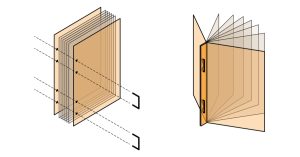As you flip through a booklet, pamphlet or magazine, you probably aren’t thinking about how its pages and cover are held together, but for those in the industry, this is a very important component of the book manufacturing process.
For booklets and magazines, a process called stab stitching is often used. Find out more about how this binding method works to hold together the pages of some of your favorite reading materials.
Stab Stitching vs Saddle Stitching
To better understand the stab stitching process, let’s start by discussing a very similar (and more commonly known) type of binding: saddle stitching.
In saddle stitching, a metal wire (similar to a staple) is punched through the center of the printed booklet pages. This is done two or three times with the staples in a line where the center fold will be. The pages are then folded in half, with the wire staples running along the spine of the booklet.
While saddle stitching is a good option for a number of types of projects, stab stitching is more cost effective. It is also a recommended option for books that are over 100 pages thick. (Saddle stitching can only accommodate up to 80 pages.)
Related: What’s in a Bind? 4 Types of Book Binding – Pros and Cons
The Stab Stitching Process
Now let’s talk about the stab stitching process. Stab stitching also involves the use of metal staples that are stitched into the booklet at two or three places along the spine. However, in stab stitching, instead of the staples being inserted down the middle fold, they are stapled on the side of the cover. It’s very similar to the way you would staple documents in the office with a handheld stapler, just on a much larger scale.
After the staples are in place, a cloth tape is applied to the spine and edges of the cover to hide the stitching, making for an attractive finish. Perforation is also a popular option for booklets of this nature. A perforated line down the side or top of the pages is useful when the user will need to rip out pages but leave the rest of the booklet intact. This feature can come in handy in booklets that are used for notepads, delivery slips and invoices.
Related: What Book Binding Method is Right for Your Print Job?
Eyeletting can also be used with stab stitching. This is the insertion of a metal rim around the inside edge of a hole drilled through the book’s pages. This allows the book to be hung from another object. Think tags or swatch books – items that will have a string or ball chain threaded through them.
Stab stitching is a convenient and inexpensive form of bookbinding for booklets that are thicker in nature, but it can be used for projects anywhere between two and 300 pages in length.
Not sure if stab stitching is the right bookbinding choice for your next publication? Contact the experts at Ironmark. Our printing team can advise you on the best method based on your specific needs. Get in touch today!




